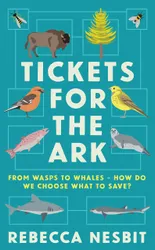This is a book about conservation, and focuses on the trade offs that have to be made when humans are making decisions about how to preserve ecosystems and species that we have on this planet. One message I took from the book is that everything is more complex than it might at first appear! We don’t fully understand how our ecosystems work, we don’t know all the roles that particular species play in those ecosystems, and we don’t know about all the species that exist. We also have biases about which species we feel motivated to save, preferring cute or iconic animals over ugly or less well known creatures and plants. The author mentions the changes that humans have brought about that have put so many species in peril, such as deforestation, pollution, hunting and climate change. But the book also contains the more hopeful message that species can be saved, and ecosystems protected, when carefully considered action is taken with the agreement of everyone involved, and when the results of these interventions are monitored so that changes can be made if things don’t go as planned.
Another aim of the book is to argue against being able to preserve or restore an idea of “pristine” nature. We’ve already opened Pandora’s box here. All over the world, there are species that don’t “belong” where they are, and many other species that shaped ecosystems have gone extinct. Humans also have to be able to coexist with nature almost everywhere. We usually can’t just declare an area of land to be free from human activity. It would be impractical as well as denying indigenous people their right to live there.
So we can’t ever go back to a version of nature that existed in the past, and it would be a completely arbitrary choice of which version of nature we tried to go back to if we did. Instead, the best results seem to come from understanding our environment as well as we can, trying to find a balance that works, and intervening when necessary in order to maintain biodiversity and the overall health of the ecosystem.
In some cases, our understanding of an ecosystem might mean that we need to introduce a species that is not native to an area, such as a grazing animal to keep certain types of vegetation from taking over, where previously there had been an extinct species which played that role. There are some interesting stories in the book about attempts to recreate close approximations to extinct species through selective breeding, such as with Aurochs, a type of wild cattle which is the ancestor of modern domesticated cows.
In other cases, certain animals or plants may need to be kept in check in order to maintain biodiversity, or to preserve particular endangered species. This approach reminds me of a nature park near where I live where ground vegetation is periodically cut back in order to encourage rare orchids to grow. If this wasn’t done, it would soon be overgrown with other plants and there would be a greater risk of the orchids going extinct. Leaving it to nature would actually result in less biodiversity.
The book is full of interesting examples, from insects to fish to great apes, to explain the author’s points. There are some examples of success stories as well as things that haven’t gone so well. The examples are very well chosen and clearly described. I was particularly interested in the story of the Guam Rail, which is a bird that is in danger of extinction due to a type of snake that had been accidentally introduced to the island on which it lives. It has been saved from extinction by being relocated to an island where the snake doesn’t exist. But in the process, the birds were cleared of any parasites they were carrying, and this (probably) resulted in the inadvertent extinction of the Guam rail louse, which only existed on this particular bird.
This book raises a lot of interesting issues and questions around conservation. How do we value one species over another? Popularity? Significance to the ecosystem as a whole? Do all species have an equal right to survive? While it definitely raises more questions than it answers, and ultimately it’s a little unsatisfying to realise that the answer is usually “it depends”, I found it a very thought provoking book. I think anyone interested in conservation would enjoy this book.
